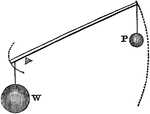Levers
This science ClipArt gallery offers 46 illustrations of levers. Levers use a rigid object with a fulcrum or pivot point, and by doing so multiply the mechanical force applied to another object.
!["The common chipping-knife, used by apothecaries, and represented [here], is a familiar illustration of levers of the second kind [class]." —Quackenbos 1859](https://etc.usf.edu/clipart/36300/36342/chipknife_36342_mth.gif)
Chipping Knife
"The common chipping-knife, used by apothecaries, and represented [here], is a familiar illustration…
Compound Lever
"When several simple levers are connected together, and act one upon the other, the machine is called…
Compound Lever
"In compound levers, equilibrium is established when the power, multiplied by the first arms of all…

Crowbar
"... shows one of the commonest (sic) forms in which this kind of lever appears,-the crowbar. The power…
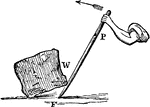
Crowbar and Stone
"... a farmer with a crowbar, as shown, can move a rock which with his hands alone he could not stir."…

First Class Lever
"A lever is an inflexible bar freely movable about a fixed axis called the fulcrum. If the fulcrum is…

First Class Lever
"A Lever of the First Kind is one in which the fulcrum is between the power and the weight... where…

Man with Lever and Fulcrum
"In mechanics, the point of rest about which a lever turns in lifting a body; also, a prop or support…

Man Using Lever and Fulcrum to Lift Rock
"In mechanics, the word 'machine' signifies an instrument for the conversion of motion or the transference…

Lever
"The object W to be lifted is called the weight; the force is represented by P; the point, or pivot,…

Lever
"The object W to be lifted is called the weight; the force is represented by P; the point, or pivot,…
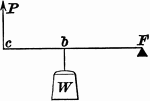
Lever
"The object W to be lifted is called the weight; the force is represented by P; the point, or pivot,…

First Class Lever
"The lever of the first class has the fulcrum between the power and the weight." Examples: a common…

First Class of Lever: Fulcrum Between Power and Weight
This illustration shows the first class of lever. This class employs a fulcrum between the power and…

First Kind of Lever
"In straight levers of the first kind, the fulcrum is between the power and the resistance, as in fig…

Second Class Lever
"The lever of the second class has the weight between the power and the fulcrum." Examples: a nutcracker,…

Second Kind of Lever
"In the second order of levers, the resistance is between the fulcrum and the power; and, as before,…

Third Class Lever
"The lever of the third class has the power between the weight and the fulcrum." Examples: sewing machine…
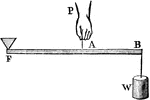
Third Kind of Lever
"In the third order of lever the power acts between the prop and the resistance, where also P : W ::…
Simple Machines
Images of different points about a fulcrum F. P is the power exerted on the object, W is the weight.
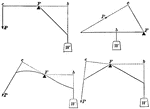
Simple Machines
Each of these are an example of the simple machine: lever. F c is the power arm and F w is the weight…

Lever Safety-valve
A safety-valve, in which a weight is employed. Here a is the valve, b b the boiler, c c the valve-seat,…

Scissors
"Many instruments in common use are on the principle of this kind of lever. Scissors, consists of two…

Second Class Lever
"A lever is an inflexible bar freely movable about a fixed axis called the fulcrum. If the weight is…
Second-class Lever
"The second kind of lever is represented where W is the weight, L the lever, F the fulcrum, and P a…
Second-class Lever
"Two men carrying a load between them on a pole is also and example of this [second class] kind of lever.…

Second Class Lever
"A Lever of the Second Kind is one in which the weight is between the power and the fulcrum." —Quackenbos…

Simple Lever
"Any rod, or bar, which is used in raising a weight, or surmounting a resistance, by being placed on…
Simple lever system
"Suppose that A is the lever, B the fulcrum, D the weight to be raised, and C the power. Let D by considered…
Simple Lever System
"Suppose the weight, B to be sixteen pounds and suppose the fulrum to be placed so near it, as to be…
Simple Lever System
"But let the fulcrum be moved along to the middle of the lever, with the weight of sixteen pounds still…

Spike Extractor
"An apparatus for extracting spikes, as from a rail. a, rail; b, spike to be extracted; c, fulcrum-piece…
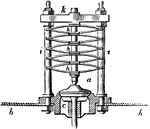
Lever Spring Safety-valve
A form of spring safety-valve, in which a series of bent springs h h h are placed alternately in opposite…

Third class lever
"A lever is an inflexible bar freely movable about a fixed axis called the fulcrum. If the power is…

Third-class Lever
"In the third and last kind of lever, the weight is placed at one end, the fulcrum at the other end…
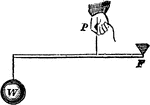
Third Class Lever
"A Lever of the Third Kind is one in which the power is between the weight and the fulcrum." —Quackenbos…
